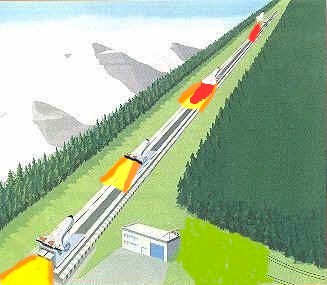Mankind needs an inexpensive method of launching spacecraft. For the past 40
years, the only method has been multi-stage expendable rockets. There has always been great interest in a single-stage Reusable Launched
Vehicle (RLV), to allow ordinary people to visit outer space for the same
cost as a trip to Europe. In fact, today’s
“Space Shuttle” was envisioned as a single-stage RLV, but that proved impractical so two
semi-reusable rocket boosters and massive disposable fuel tank are needed, which pushes the total cost for each mission over $550
million. As a result, hopes for 100
shuttle launches a year have dwindled to four a year. NASA canceled a more
recent attempt at a single-stage RLV, the X-33/Venturestar, when problems
proved insurmountable. 
The solution is a "Sky Ramp" assisted-launch to propel an RLV on a sled to supersonic speeds up a two mile long inclined track before the RLV fires its engines. This can be done with today's rocket engines at less than six Gs from a variety of proven tracks. The sled can also launch any airborne vehicle, including Mach 3+ ramjet powered aircraft or spaceplanes. This does not require a technological breakthrough; the scientists and engineers at Sky Ramp Technology have proven this concept viable using existing technology.
A Sky Ramp provides a tremendous boost because the first two miles of space launch burn tremendous fuel to gain momentum and push through the dense atmosphere near the Earth's surface. NASA studies show that a Mach 2 assisted launch can reduce the fuel needed to make orbit by 40%, allowing a single-stage RLV to make orbit with a substantial payload. Rocket sled assisted launch off a Sky Ramp is the only viable method of inexpensive space launch. All other proposed methods are not feasible, click the "Others" button on top for more. This is the most important space launch discovery in decades, and the people at Sky Ramp Technology seek your help in promoting this method. For details, visit the Sky Ramp Technology website.